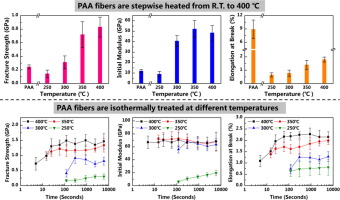当前位置:
X-MOL 学术
›
Eur. Polym. J.
›
论文详情
Our official English website, www.x-mol.net, welcomes your
feedback! (Note: you will need to create a separate account there.)
Influence of thermal treatment on the structure and mechanical properties of one aromatic BPDA-PDA polyimide fibers
European Polymer Journal ( IF 5.8 ) Pub Date : 2017-11-01 , DOI: 10.1016/j.eurpolymj.2017.09.015 Wenke Yang , Fangfang Liu , Jidong Zhang , Ensong Zhang , Xuepeng Qiu , Xiangling Ji
European Polymer Journal ( IF 5.8 ) Pub Date : 2017-11-01 , DOI: 10.1016/j.eurpolymj.2017.09.015 Wenke Yang , Fangfang Liu , Jidong Zhang , Ensong Zhang , Xuepeng Qiu , Xiangling Ji

|
Abstract Polyamic acid (PAA) fiber derived from 3,3′,4,4′-biphenyltetra-carboxylic dianhydride and p -phenylenediamine is prepared via dry-jet wet-spinning method. Polyimide (PI) fibers are obtained by applying two kinds of thermal treatment procedures on the PAA fibers. The evolution of fiber structure during thermal treatments is traced. And the influence of fiber structure on the mechanical properties is also studied. In Procedure I, the PAA fibers are heated from room temperature to 400 °C at 5 °C/min. As temperature increases from room temperature to 125 °C, relaxation behavior of PAA chains happens at first. Then, from 125 to 300 °C, imidization reaction occurs. Meanwhile, before the temperature reaches 250 °C, a significant degradation of PAA chains exists and makes the fibers too weak to measure. Crystals in fiber begin to form as temperature exceeds 250 °C and totally complete at 350 °C. The fracture strength and initial modulus of fiber are significantly improved with the formation of crystals and finally reach 0.83 GPa and 48.4 GPa at 400 °C, respectively. In Procedure II, the PAA fibers are isothermally treated at 250, 300, 350 and 400 °C for different times. When treated at 400 and 350 °C, both imidization and crystallization in fiber can happen simultaneously and complete in tens of seconds because of the high mobility of the polymer chains. While as treated at 300 and 250 °C, both these two processes are slowed down and the formation of crystals lags behind the imidization process. High crystallinity can be obtained under higher treatment temperature in a very short time. The mechanical properties of fiber highly depend on the treatment temperature rather than the treatment time. The fibers treated at 400 °C for 60 s show the highest fracture strength and initial modulus of 1.4 GPa and 70.0 GPa, respectively.
中文翻译:

热处理对一种芳香族BPDA-PDA聚酰亚胺纤维结构和力学性能的影响
摘要 采用干喷湿纺法制备了以3,3',4,4'-联苯四甲酸二酐和对苯二胺为原料的聚酰胺酸(PAA)纤维。聚酰亚胺 (PI) 纤维是通过对 PAA 纤维应用两种热处理程序获得的。跟踪热处理过程中纤维结构的演变。并研究了纤维结构对力学性能的影响。在程序 I 中,PAA 纤维以 5°C/分钟的速度从室温加热到 400°C。随着温度从室温升高到 125 °C,首先发生 PAA 链的松弛行为。然后,从 125 到 300 °C,发生酰亚胺化反应。同时,在温度达到 250 °C 之前,PAA 链存在显着降解,使纤维太弱而无法测量。纤维中的晶体在温度超过 250 °C 时开始形成,并在 350 °C 时完全完成。纤维的断裂强度和初始模量随着晶体的形成而显着提高,最终在 400°C 下分别达到 0.83 GPa 和 48.4 GPa。在程序II中,PAA纤维在250、300、350和400°C下等温处理不同时间。当在 400 和 350 °C 下处理时,由于聚合物链的高流动性,纤维中的酰亚胺化和结晶可以同时发生并在数十秒内完成。而在 300 和 250 °C 下处理时,这两个过程都会减慢,并且晶体的形成落后于酰亚胺化过程。在较高的处理温度下可以在很短的时间内获得高结晶度。纤维的机械性能高度依赖于处理温度而不是处理时间。在 400 °C 下处理 60 秒的纤维显示出最高的断裂强度和初始模量,分别为 1.4 GPa 和 70.0 GPa。
更新日期:2017-11-01
中文翻译:

热处理对一种芳香族BPDA-PDA聚酰亚胺纤维结构和力学性能的影响
摘要 采用干喷湿纺法制备了以3,3',4,4'-联苯四甲酸二酐和对苯二胺为原料的聚酰胺酸(PAA)纤维。聚酰亚胺 (PI) 纤维是通过对 PAA 纤维应用两种热处理程序获得的。跟踪热处理过程中纤维结构的演变。并研究了纤维结构对力学性能的影响。在程序 I 中,PAA 纤维以 5°C/分钟的速度从室温加热到 400°C。随着温度从室温升高到 125 °C,首先发生 PAA 链的松弛行为。然后,从 125 到 300 °C,发生酰亚胺化反应。同时,在温度达到 250 °C 之前,PAA 链存在显着降解,使纤维太弱而无法测量。纤维中的晶体在温度超过 250 °C 时开始形成,并在 350 °C 时完全完成。纤维的断裂强度和初始模量随着晶体的形成而显着提高,最终在 400°C 下分别达到 0.83 GPa 和 48.4 GPa。在程序II中,PAA纤维在250、300、350和400°C下等温处理不同时间。当在 400 和 350 °C 下处理时,由于聚合物链的高流动性,纤维中的酰亚胺化和结晶可以同时发生并在数十秒内完成。而在 300 和 250 °C 下处理时,这两个过程都会减慢,并且晶体的形成落后于酰亚胺化过程。在较高的处理温度下可以在很短的时间内获得高结晶度。纤维的机械性能高度依赖于处理温度而不是处理时间。在 400 °C 下处理 60 秒的纤维显示出最高的断裂强度和初始模量,分别为 1.4 GPa 和 70.0 GPa。











































 京公网安备 11010802027423号
京公网安备 11010802027423号